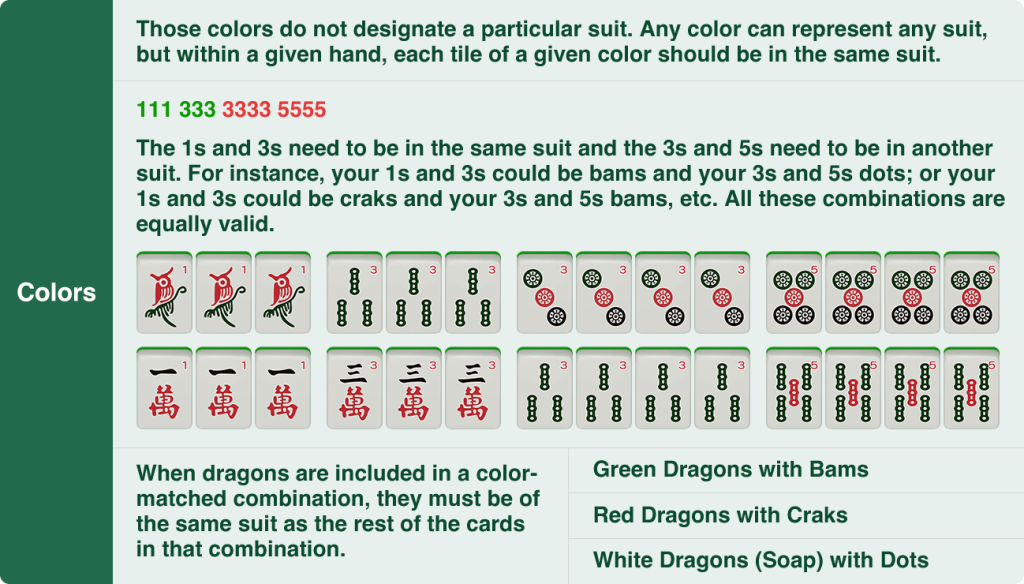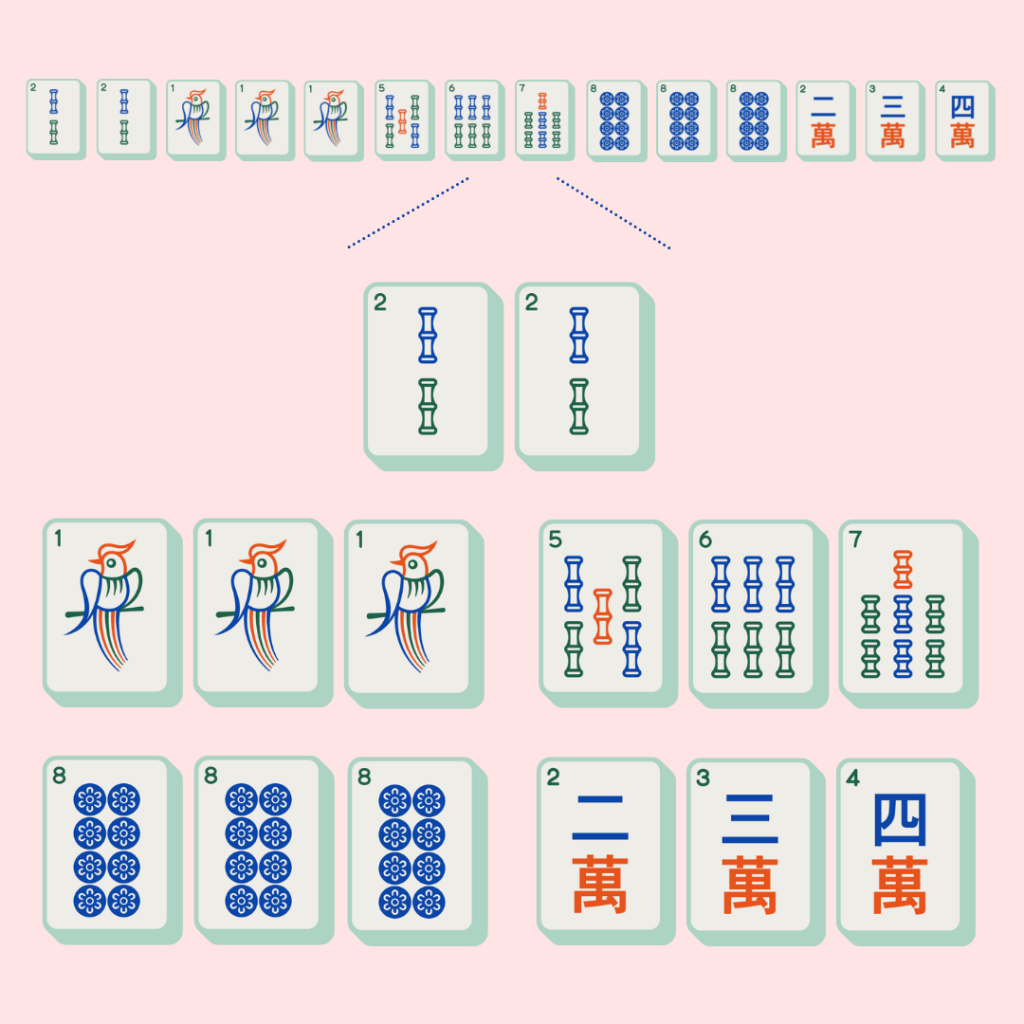
American Mahjong differs in that it adds a lively social component to the Chinese game it is based on. It is played with a set of 152 tiles which includes Jokers and an Annual Card which designates the winning (Mah Jongg) hands that players attempt to build. This game is also a very popular social event for groups that like to play at clubs or family gatherings. This version is not the Mahjong Solitaire version played in a web browser, here is how to play American Mahjong, step by step.
Basics of American Mahjong
The American set has 152 tiles. It includes the 144 tiles that are used in a standard set, plus eight Jokers. The Jokers are used as wilds in most melds. The game is played by four players, seated around a square table.
The players play out the rounds of play in a rotating fashion, East, South, West and North Winds. Each year, the National Mah Jongg League gives players an Official Annual Scorecard. This Scorecard lists 50-60 hands, some open melds and some concealed melds. Players must build towards these designated combinations in order to get Mah Jongg. Therefore, players must use the Scorecard during their game for reference.
Jokers can represent any tile except the Winds, Dragons and lone pairs or singles, but cannot complete a lone tile or a pair tile either. Usually, hands consist of five melds: four melds and a pair, and the points are reflected on the Annual Scorecard. Play is then begun after the set up of the game is completed and players discard. The discards are an important phase of the game to employ various strategies because of the nature of the American game.
Beginning players can find the card easy to comprehend, while advanced players use Joker efficiency strategies in their games. Online apps suited for the practice of the Annual Card can be easily found. This platform is what sets this game apart from the traditional games.
Preparation For Your American Mahjong Set
You need a complete set of 152 tiles, four of each suit of numbered tiles (Dots, Bams, Craks 1-9), Winds, Dragons, besides Tiles as flowers, jokers and 8 blank seasons, racks for concealing the hands, 4 paddles for the walls, 2 dice, and the score card thereof for the year covered. Shuffle the tiles over a mat face down in order to vary them, and not look. Thus, a properly equipped set prevents interruptions to the sessions.
Examine the tiles for clearness. The jokers generally have a jester design on them, dragons are very bright in color, Reddish, Green, White. Store away in a protective case to maintain the quality. Beginners will have plastic sets on account of wear and tear on them, while collectors will have the engraved bamboo. Thus, preparation leads to smoothness in playing.
If you have a score card, look to see if the counts of the hands are set forth thereon, as they are changed every year on account of the different occasions which can be celebratory, holiday times, etc. There are also electronic versions to accommodate. This ritual of preparation creates anticipation. The prep. (preparation) is a prelude to action.

Building the Walls and Dealing Out the Tiles
The walls are built in stacks of 19 two high (38 tiles) facing your rack into a square compound. Dice will be cast to determine who is East either of the two highest breaks down the wall, counting the stacks to be removed from his right according to the number of spots showing on the dice and turning them under according to the remainder.
East deals first for himself, taking two stacks (4 tiles) evenly one for himself and as many more counterclockwise for two more till he has dealt to each of the players 12 hands, turning under the walls sufficient for the purpose. Subsequently, East receives an additional two tiles from the top of stacks 1 and 3 and passes one to each player in turn in counter-clockwise direction, thus leaving each player with thirteen tiles and East with fourteen. Arrange tiles in racks out of sight, placing Flowers and Seasons face up beside racks for points. If East has a complete hand after the deal, declare it Mah Jongg then and there. If not, the passing phase follows. Dealing thus incorporates interest and balance early in the game.
When walls are exhausted they should be pushed around in rotation in a clockwise manner preserving the square formation. Practise dealing alone until you master the charming grace of the curtsies. A transition follows strategy. For the walls being evenly built the sincerity of the game is already established.
Mastering the Charleston Tile Passing
Take first Charleston which is compulsory, and pass three out of five unnecessary tiles to the right, then to the other side, then afterwards to the left (optional blind passing, stealing from three to none of tiles received unseen). If all agree, have the optional second Charleston and do it in reverse, to the left, then to the other side and then to the right, with blind passes in the last rightward passing. End with a courtesy pass to the other side, where dealers negotiate for the exchange of three to none of tiles for as small numbers as needed. To be remembered, that the Jokers never pass, for they are of such worth that they retain their wild purposes.
The passing indicates a polishing up of hands of forming cards and by all means dropping worthless or unnecessary tiles of high point value. The tiles given are peeped into in spite of the blinds, which however give an opening for the adaptability of strategy. Harnessed to this is the fact that a spirit of co-operation preceding opposition is engendered in this ritual passing. On this account Charleston equalizes all chances, and introduces intimacy at the table.
Do not be obliged to take the second Charleston if hands are making by way of improvement. During courtesy and passing times, be courteous to each other so as to avoid disputes of course. Practise passing again and again in mock games. Safe and sane Charleston lays a high road for winning.

Essential Rules of Play and Meld Formation
East discards first, when naming tile face up in the centre, play goes on in counter clockwise direction. At your turn, draw from the inside end of the wall, rack it (signalling no possible calls on any previous discard), and discard unless a call is made. Melds are Pung (three alike), Kong (four alike or Joker-toed) and Quint (five for bonuses), Chow (three in a row in one suit, callable only by the next player). Call discards for melds in their priority: Mah Jongg first, then Kong or Pung, then Chow, showing all melds face side upwards before your rack.
Declare Kongs by adding to exposed Pungs, taking a replacement from the end wall. Jokers can be used in melds, but not pairs or singles. Discards previously made are considered dead ones, not callables. It is therefore the question of proper tagging which has its balancing as to advancement and concealment.
Expose melds horizontally for Pungs and Kongs, vertically for Chows. Racking means being committed to your discard. The flow is so arranged as to compel an active solicitude in scanning. The rules have preserved the pace and the standing.
An Understanding of The Hands from the Annual Card
The score card has a list of the hands like the numbered forms 1-5 (as instance 111 222 is the concealed the keeper will play of his hand of meld) or the various Winds or Dragons, quints in hands, each having a list of point values in score, from twenty to fifty, besides double points. The hand splits in concealed (wall drawn only, and that saves the last call), and Exposed (melded) with Jokers being good in most except Honors. Five sections to take, four groups or Odds as they are called (melds) plus an eye (pair) which equals exactly a line. So the Annual Card is the guide to every decision taken to get valid Mah Jongg.
The Bonuses are of points gained from Flowers and from Seasons per one each), double Kongs, quints. Flexible hands must be played for at the most benefit early in the game, making the switch with discards. The annual subjects are effective change, as for the current year, the floral forms appear in 2025.
